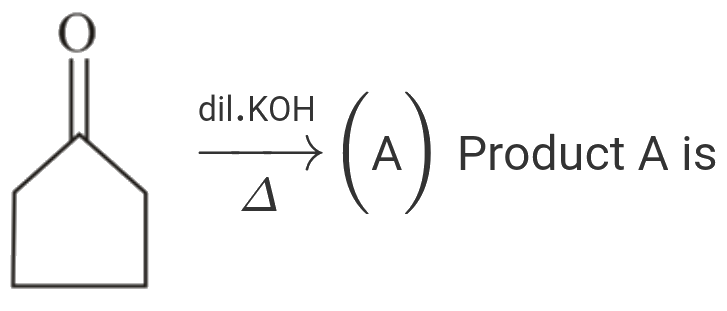Predict the products with configurations in the following.
(a) (+)2−Octanol+PhSO2Cl→(A)Hot−−−→NaOH(B)
To solve the problem, we need to predict the products of the reaction between (+)2-octanol and benzene sulfonyl chloride (PhSO₂Cl), followed by treatment with hot sodium hydroxide (NaOH).
Step 1: Understand the Reactants
- The first reactant is (+)2-octanol, which has the following structure:
CH3|CH3−CH−CH2−CH2−CH2−CH3|OH
- The second reactant is benzene sulfonyl chloride (PhSO₂Cl), which has the structure:
O∣∣Ph−S−Cl
Step 2: Reaction of 2-Octanol with PhSO₂Cl
- The hydroxyl group (OH) of 2-octanol can act as a nucleophile and attack the sulfur atom in PhSO₂Cl. This results in the formation of an intermediate sulfonate ester.
- The chlorine atom (Cl) leaves as a chloride ion (Cl⁻), and we form the sulfonate ester (A):
CH3|CH3−CH−CH2−CH2−CH2−CH3|O−SO2Ph
Step 3: Reaction of A with Hot NaOH
- The sulfonate ester (A) can undergo an SN2 reaction with hot sodium hydroxide (NaOH). The hydroxide ion (OH⁻) acts as a nucleophile and attacks the carbon atom bonded to the sulfonate group.
- This reaction results in the substitution of the sulfonate group with a hydroxyl group, leading to the formation of the final product (B), which is 2-octanol again:
CH3|CH3−CH−CH2−CH2−CH2−CH3|OH
Final Products:
- Product A: Sulfonate ester of 2-octanol
- Product B: 2-octanol
Configurations:
- For product A, the configuration remains the same as that of 2-octanol since the nucleophilic attack does not change the stereochemistry at the chiral center.
- For product B, it is the same as the original 2-octanol.
- The first reactant is (+)2-octanol, which has the following structure:
CH3|CH3−CH−CH2−CH2−CH2−CH3|OH
- The second reactant is benzene sulfonyl chloride (PhSO₂Cl), which has the structure:
O∣∣Ph−S−Cl
- The hydroxyl group (OH) of 2-octanol can act as a nucleophile and attack the sulfur atom in PhSO₂Cl. This results in the formation of an intermediate sulfonate ester.
- The chlorine atom (Cl) leaves as a chloride ion (Cl⁻), and we form the sulfonate ester (A):
CH3|CH3−CH−CH2−CH2−CH2−CH3|O−SO2Ph
- The sulfonate ester (A) can undergo an SN2 reaction with hot sodium hydroxide (NaOH). The hydroxide ion (OH⁻) acts as a nucleophile and attacks the carbon atom bonded to the sulfonate group.
- This reaction results in the substitution of the sulfonate group with a hydroxyl group, leading to the formation of the final product (B), which is 2-octanol again:
CH3|CH3−CH−CH2−CH2−CH2−CH3|OH
- Product A: Sulfonate ester of 2-octanol
- Product B: 2-octanol
- For product A, the configuration remains the same as that of 2-octanol since the nucleophilic attack does not change the stereochemistry at the chiral center.
- For product B, it is the same as the original 2-octanol.
Topper's Solved these Questions
- ORGANIC REACTION MECHANISMBOOK - CENGAGE CHEMISTRY ENGLISHCHAPTER - ORGANIC REACTION MECHANISMEXERCISE - Comprehension
35 Videos
- ORGANIC REACTION MECHANISMBOOK - CENGAGE CHEMISTRY ENGLISHCHAPTER - ORGANIC REACTION MECHANISMEXERCISE - Multiple Correct
30 Videos
- ORGANIC REACTION MECHANISMBOOK - CENGAGE CHEMISTRY ENGLISHCHAPTER - ORGANIC REACTION MECHANISMEXERCISE - Solved Example
33 Videos
- NCERT BASED EXERCISEBOOK - CENGAGE CHEMISTRY ENGLISHCHAPTER - NCERT BASED EXERCISEEXERCISE - Chemical Equilibrium
73 Videos
- P-BLOCK GROUP 13 - BORON FAMILYBOOK - CENGAGE CHEMISTRY ENGLISHCHAPTER - P-BLOCK GROUP 13 - BORON FAMILYEXERCISE - Exercise Archives (Subjecive)
9 Videos
Similar Questions
The product "A" in the following reaction is :CH3−CO−CH2COOC2H5NaOH−−−−−−→H2OA
View SolutionPredict product(s) in the following reaction,
Cl2+OH−hot−−→?
View SolutionIn the following reaction sequence Y is,
PhOCOCH3AlCl3−−→Δ(X)I2−−−→NaOH(Y)
View SolutionWrite down the main product of the following reaction. Propanal NaOH−−−→heat
View Solution dil.KOH−−−−→Δ(A) Product A is
dil.KOH−−−−→Δ(A) Product A is
View SolutionWrite major product in the following reactions :
C6H5−CH=CH2+B2H6H2O2−−−→NaOH
View SolutionComplete the following reactions:
(A)Glyoxal1.NaOH−−−−−→2.H3O⊕(B)
View SolutionHNO3/H2SO4−−−−−−−−→ANaOH−−−−−→433KB, B is

View SolutionIn the following sequence of recation, identify the compounds (A), (B), (C ) and (D):
NSolutiona2CO3SO2−−→(A)Na2CO3−−−−→(B)S−−→Heat(C)AgNO3−−−→(D)
View SolutionThe end product (B) in the following sequence of reactions is CH3ClKCN−−→AH2O/H+−−−−−→B
View Solution
